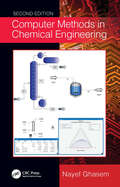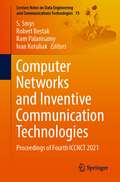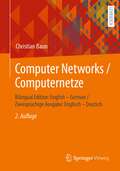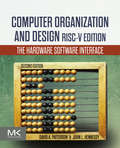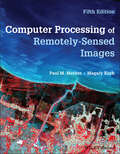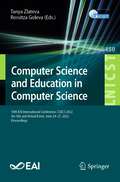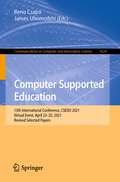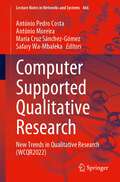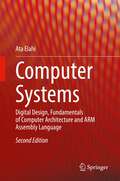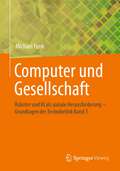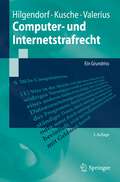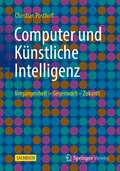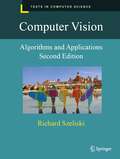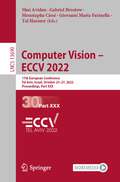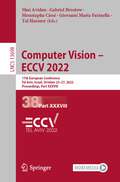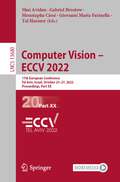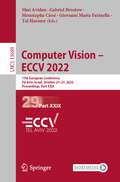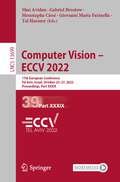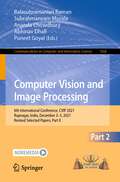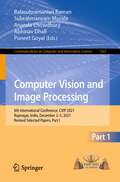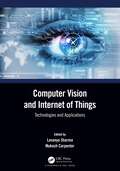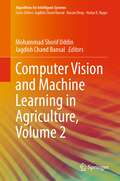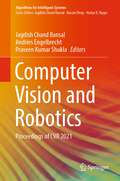- Table View
- List View
Computer Methods in Chemical Engineering
by Nayef GhasemWhile various software packages have become essential for performing unit operations and other kinds of processes in chemical engineering, the fundamental theory and methods of calculation must also be understood to effectively test the validity of these packages and verify the results. Computer Methods in Chemical Engineering, Second Edition presents the most used simulation software along with the theory involved. It covers chemical engineering thermodynamics, fluid mechanics, material and energy balances, mass transfer operations, reactor design, and computer applications in chemical engineering. The highly anticipated Second Edition is thoroughly updated to reflect the latest updates in the featured software and has added a focus on real reactors, introduces AVEVA Process Simulation software, and includes new and updated appendixes. Through this book, students will learn the following: What chemical engineers do The functions and theoretical background of basic chemical engineering unit operations How to simulate chemical processes using software packages How to size chemical process units manually and with software How to fit experimental data How to solve linear and nonlinear algebraic equations as well as ordinary differential equations Along with exercises and references, each chapter contains a theoretical description of process units followed by numerous examples that are solved step by step via hand calculation and computer simulation using Hysys/UniSim, PRO/II, Aspen Plus, and SuperPro Designer. Adhering to the Accreditation Board for Engineering and Technology (ABET) criteria, the book gives chemical engineering students and professionals the tools to solve real problems involving thermodynamics and fluid-phase equilibria, fluid flow, material and energy balances, heat exchangers, reactor design, distillation, absorption, and liquid extraction. This new edition includes many examples simulated by recent software packages. In addition, fluid package information is introduced in correlation to the numerical problems in book. An updated solutions manual and PowerPoint slides are also provided in addition to new video guides and UniSim program files.
Computer Networks and Inventive Communication Technologies: Proceedings of Fourth ICCNCT 2021 (Lecture Notes on Data Engineering and Communications Technologies #75)
by S. Smys Robert Bestak Ram Palanisamy Ivan KotuliakThis book is a collection of peer-reviewed best-selected research papers presented at 4th International Conference on Computer Networks and Inventive Communication Technologies (ICCNCT 2021). The book covers new results in theory, methodology, and applications of computer networks and data communications. It includes original papers on computer networks, network protocols and wireless networks, data communication technologies, and network security. The proceedings of this conference are a valuable resource, dealing with both the important core and the specialized issues in the areas of next-generation wireless network design, control, and management, as well as in the areas of protection, assurance, and trust in information security practice. It is a reference for researchers, instructors, students, scientists, engineers, managers, and industry practitioners for advanced work in the area.
Computer Networks / Computernetze: Bilingual Edition: English – German / Zweisprachige Ausgabe: Englisch – Deutsch
by Christian BaunMit diesem Buch erlangen Sie Grundlagenwissen im Bereich der ComputernetzwerkeDieses Buch bietet Ihnen einen kompakten Überblick über das Thema Computernetzwerke. Sein Aufbau orientiert sich an den Schichten der etablierten Referenzmodelle und behandelt für jede Schicht die Geräte und die wichtigsten Protokolle. Zu den Protokollen gehören auch Netzwerktechnologien wie Ethernet, WLAN, Bluetooth usw. und die Übertragungsmedien.Das Ziel des Buches ist es nicht, eine Auflistung von Algorithmen zu schaffen, sondern eine an der Realität orientierte Beschreibung zu liefern, die die wichtigsten Technologien in einem klaren Zusammenhang behandelt. Das Buch soll dem Leser ein fundiertes Verständnis von Computernetzwerken in kompakter Form vermitteln.Das Besondere dabei ist die zweisprachige Darstellung des Inhalts. In zwei Spalten stehen der deutsche und der englische Text nebeneinander, so dass der Leser gleichzeitig seine Sprachkenntnisse und sein Fachvokabular verbessern kann. Das Buch richtet sich vor allem an Studierende der Informatik und an alle am Thema Interessierten. Diese Inhalte vermittelt der Autor dem LeserChristian Baun vermittelt dem Leser in seinem Buch alle wichtigen Grundlagen der Computernetzwerke. Dazu gehören unter anderen:· Grundlagen der Informations- und Netzwerktechnik· Grundlagen der Computervernetzung· Protokolle und Protokollschichten· Bitübertragungsschicht· Sicherungsschicht· Vermittlungsschicht· Transportschicht· Anwendungsschicht· Netzwerkvirtualisierung· Funktionsweise des OSI-Referenzmodells· Kommandozeilenwerkzeuge Mithilfe dieser Inhalte erhält der Leser einen kompakten Einblick in die Thematik.---This book presents a compact, yet detailed overview and introduction to computer networks and their components. The book is written in both English and German, arranged in side-by-side columns. This feature helps readers improve and broaden their language skills, and gain familiarity with the specialized vocabulary of computer science and networking at the same time. The book opens with a review of computer science basics, including the building blocks of data, file and storage dimensions, and Unicode. The fundamentals of computer networking are presented, with sections on the dimensions of different types of networks, data transmission, and media access control. Protocols and reference models are explained, followed by chapters on the functional layers of networks: Physical Layer, Data Link Layer, Network Layer, Transport Layer, and Application Layer. Additional topics covered include:· Computer network topologies· Bandwidth and latency· Network virtualization The book includes a collection of command line tools for network configuration and for analyzing network-related issues. The book concludes with a list of technical terms, and an extensive glossary, both presented in side-by-side columns, in English and German. Requiring little to no technical background, Computer Networks – Computernetze benefits college-level students interested in computer science. It is especially useful for students and working professionals who wish to improve their knowledge of
Computer Organization and Design RISC-V Edition: The Hardware Software Interface (ISSN)
by David A. Patterson John L. HennessyComputer Organization and Design RISC-V Edition: The Hardware Software Interface, Second Edition, the award-winning textbook from Patterson and Hennessy that is used by more than 40,000 students per year, continues to present the most comprehensive and readable introduction to this core computer science topic. This version of the book features the RISC-V open source instruction set architecture, the first open source architecture designed for use in modern computing environments such as cloud computing, mobile devices, and other embedded systems. Readers will enjoy an online companion website that provides advanced content for further study, appendices, glossary, references, links to software tools, and more.Covers parallelism in-depth, with examples and content highlighting parallel hardware and software topicsFocuses on 64-bit address, ISA to 32-bit address, and ISA for RISC-V because 32-bit RISC-V ISA is simpler to explain, and 32-bit address computers are still best for applications like embedded computing and IoTIncludes new sections in each chapter on Domain Specific Architectures (DSA)Provides updates on all the real-world examples in the book
Computer Processing of Remotely-Sensed Images
by Paul M. Mather Magaly KochComputer Processing of Remotely-Sensed Images A thorough introduction to computer processing of remotely-sensed images, processing methods, and applications Remote sensing is a crucial form of measurement that allows for the gauging of an object or space without direct physical contact, allowing for the assessment and recording of a target under conditions which would normally render access difficult or impossible. This is done through the analysis and interpretation of electromagnetic radiation (EMR) that is reflected or emitted by an object, surveyed and recorded by an observer or instrument that is not in contact with the target. This methodology is particularly of importance in Earth observation by remote sensing, wherein airborne or satellite-borne instruments of EMR provide data on the planet’s land, seas, ice, and atmosphere. This permits scientists to establish relationships between the measurements and the nature and distribution of phenomena on the Earth’s surface or within the atmosphere. Still relying on a visual and conceptual approach to the material, the fifth edition of this successful textbook provides students with methods of computer processing of remotely sensed data and introduces them to environmental applications which make use of remotely-sensed images. The new edition’s content has been rearranged to be more clearly focused on image processing methods and applications in remote sensing with new examples, including material on the Copernicus missions, microsatellites and recently launched SAR satellites, as well as time series analysis methods. The fifth edition of Computer Processing of Remotely-Sensed Images also contains: A cohesive presentation of the fundamental components of Earth observation remote sensing that is easy to understand and highly digestible Largely non-technical language providing insights into more advanced topics that may be too difficult for a non-mathematician to understand Illustrations and example boxes throughout the book to illustrate concepts, as well as revised examples that reflect the latest information References and links to the most up-to-date online and open access sources used by students Computer Processing of Remotely-Sensed Images is a highly insightful textbook for advanced undergraduates and postgraduate students taking courses in remote sensing and GIS in Geography, Geology, and Earth & Environmental Science departments.
Computer Processing of Remotely-Sensed Images: An Introduction
by Paul M. Mather Magaly KochComputer Processing of Remotely-Sensed Images A thorough introduction to computer processing of remotely-sensed images, processing methods, and applications Remote sensing is a crucial form of measurement that allows for the gauging of an object or space without direct physical contact, allowing for the assessment and recording of a target under conditions which would normally render access difficult or impossible. This is done through the analysis and interpretation of electromagnetic radiation (EMR) that is reflected or emitted by an object, surveyed and recorded by an observer or instrument that is not in contact with the target. This methodology is particularly of importance in Earth observation by remote sensing, wherein airborne or satellite-borne instruments of EMR provide data on the planet’s land, seas, ice, and atmosphere. This permits scientists to establish relationships between the measurements and the nature and distribution of phenomena on the Earth’s surface or within the atmosphere. Still relying on a visual and conceptual approach to the material, the fifth edition of this successful textbook provides students with methods of computer processing of remotely sensed data and introduces them to environmental applications which make use of remotely-sensed images. The new edition’s content has been rearranged to be more clearly focused on image processing methods and applications in remote sensing with new examples, including material on the Copernicus missions, microsatellites and recently launched SAR satellites, as well as time series analysis methods. The fifth edition of Computer Processing of Remotely-Sensed Images also contains: A cohesive presentation of the fundamental components of Earth observation remote sensing that is easy to understand and highly digestible Largely non-technical language providing insights into more advanced topics that may be too difficult for a non-mathematician to understand Illustrations and example boxes throughout the book to illustrate concepts, as well as revised examples that reflect the latest information References and links to the most up-to-date online and open access sources used by students Computer Processing of Remotely-Sensed Images is a highly insightful textbook for advanced undergraduates and postgraduate students taking courses in remote sensing and GIS in Geography, Geology, and Earth & Environmental Science departments.
Computer Science and Education in Computer Science: 18th EAI International Conference, CSECS 2022, On-Site and Virtual Event, June 24-27, 2022, Proceedings (Lecture Notes of the Institute for Computer Sciences, Social Informatics and Telecommunications Engineering #450)
by Tanya Zlateva Rossitza GolevaThis book constitutes the refereed post-conference proceedings of the 18th EAI International Conference on Computer Science and Education in Computer Science, CSECS 2022, held in June 2022 in Sofia, Bulgaria. Due to COVID-19 pandemic the conference was held On-Site and virtually.The 15 full papers and 9 short papers were carefully reviewed and selected from 53 submissions. The papers present are grouped into 2 tracks, i.e., computer science implementations and education in computer science. CSECS conference presents research in software engineering and information systems design, cryptography, the theoretical foundation of the algorithms, and implementation of machine learning and big data technologies. Another important topic of the conference is the education in computer science which includes the introduction and evaluation of computing programs, curricula, and online courses, to syllabus, laboratories, teaching, and pedagogy aspects. The technical and education topics evolved multiple existing and emerging technologies, solutions, and services for design and training providing a heterogeneous approach towards delivering Software 4.0 and Education 4.0 to a broad range of citizens and societies.
Computer Supported Education: 13th International Conference, CSEDU 2021, Virtual Event, April 23–25, 2021, Revised Selected Papers (Communications in Computer and Information Science #1624)
by James Uhomoibhi Beno CsapóThis book constitutes selected, revised and extended papers from the 13th International Conference on Computer Supported Education, CSEDU 2021, held as a virtual event in April 2021.The 27 revised full papers were carefully reviewed and selected from 143 submissions. They were organized in topical sections as follows: artificial intelligence in education; information technologies supporting learning; learning/teaching methodologies and assessment; social context and learning environments; ubiquitous learning; current topics.
Computer Supported Qualitative Research: New Trends in Qualitative Research (WCQR2022) (Lecture Notes in Networks and Systems #466)
by António Pedro Costa António Moreira Maria Cruz Sánchez‑Gómez Safary Wa-MbalekaThis book includes selecting the articles accepted for presentation and discussion at WCQR2022, held on January 26 to 28, 2022 (Virtual Conference). The World Conference on Qualitative Research (WCQR) is an annual event that aims to bring together researchers, academics and professionals, promoting the sharing and discussion of knowledge, new perspectives, experiences and innovations on qualitative research. WCQR2022 featured four main application fields (education, health, social sciences, and engineering/technology) and seven main subjects: Rationale and paradigms of qualitative research; systematization of approaches with qualitative studies; qualitative and mixed methods research; data analysis types; innovative processes of qualitative data analysis; qualitative research in Web context; and qualitative analysis with software support. The book is a valuable resource for everyone interested in qualitative research, emphasizing computer-assisted qualitative data analysis software (CAQDAS).
Computer Systems: Digital Design, Fundamentals of Computer Architecture and ARM Assembly Language
by Ata ElahiThis updated textbook covers digital design, fundamentals of computer architecture, and ARM assembly language. The book starts by introducing computer abstraction, basic number systems, character coding, basic knowledge in digital design, and components of a computer. The book goes on to discuss information representation in computing, Boolean algebra and logic gates, and sequential logic. The book also presents introduction to computer architecture, Cache mapping methods, and virtual memory. The author also covers ARM architecture, ARM instructions, ARM assembly language using Keil development tools, and bitwise control structure using C and ARM assembly language. The book includes a set of laboratory experiments related to digital design using Logisim software and ARM assembly language programming using Keil development tools. In addition, each chapter features objectives, summaries, key terms, review questions, and problems.
Computer und Gesellschaft: Roboter und KI als soziale Herausforderung – Grundlagen der Technikethik Band 3
by Michael FunkWelche Wirkungen haben Robotik und Künstliche Intelligenz (KI) auf die Gesellschaft? Wie verändern Algorithmen und Machine Learning unser soziales Umfeld? Vor welchen ethischen Herausforderungen stehen wir? Vorliegendes Buch bietet zu diesen und weiteren Fragen systematische Analysen. Allgemeine und spezielle Roboterkonzepte von Androiden über Social Robots bis hin zu kollaborativen Industrierobotern werden vorgestellt. Hinzu treten Drohnen im militärischen und zivilen Einsatz sowie diverse Formen der Mensch-Maschine-, Tier-Maschine- und Pflanze-Maschine-Interaktion. Verschiedene Begriffe und Paradigmen der KI werden auch abseits der Informatik herausgearbeitet, reale und spekulative Entwicklungen eingeordnet. Vor diesem Hintergrund geraten ethisch-gesellschaftliche Brennpunkte in den Blick. Beispiele, Aufgaben, vertiefende Infos zu Hintergründen und Übersichten laden zum kritischen Weiterdenken ein. Es bildet den dritten, in sich abgerundeten Teil der Buchreihe Grundlagen der Technikethik.Haben wir die Zukunft, die wir brauchen, und brauchen wir die Zukunft, die wir haben?
Computer- und Internetstrafrecht: Ein Grundriss (Springer-Lehrbuch)
by Eric Hilgendorf Carsten Kusche Brian ValeriusDie Informations- und Kommunikationstechnologie stellt das Strafrecht vor die Aufgabe, sowohl klassische Delikte in ihrem neuen technisierten Gewand zu erfassen als auch ganz neuen Kriminalitätsformen zu begegnen. Das Lehrbuch vermittelt einen umfassenden Überblick über das Rechtsgebiet und zeigt die aktuellen Probleme auf. Die 2. Auflage berücksichtigt Entwicklungen in Gesetzgebung und Rechtsprechung und enthält ein neues Kapitel zu strafverfahrensrechtlichen Fragen im Zusammenhang mit Computern und Computernetzwerken.
Computer und Künstliche Intelligenz: Vergangenheit - Gegenwart - Zukunft
by Christian PosthoffDas Buch beginnt mit einer Erklärung der menschlichen Intelligenz und der Beschreibung von Intelligenztests. Die Künstliche Intelligenz, die auf Computerprogrammen beruht, beginnt mit der Dartmouth – Konferenz 1956, an der sich berühmte Informatiker dieser Zeit beteiligten. Diese damit eingeleitete Entwicklung wurde von großen Fortschritten der Kybernetik und der Spieltheorie begleitet.Es folgen Beschreibungen wichtiger Methoden und Anwendungen:Maschinelles Lernen und Neuronale Netze Sehr publikumswirksam waren die Entwicklungen von Programmen für strategische Spiele, die nach einem kurzen Training die jeweiligen Weltmeister besiegen konnten. Die Sprachübersetzer von Google und DeepL sind mittlerweile vielen bekannt. Es wird erklärt, wie intelligente Systeme mit Datenbanken zusammenarbeiten, wie beliebige Daten digitalisiert werden können. Große Mengen an Daten werden unter dem Stichwort „Big Data“ behandelt. Ausführlich beschrieben werden die Bildverarbeitung, die Erkennung von Tumoren und Viren. Robotik ist ein weiterer Punkt, der ausführlich dargestellt wird. Roboter in der Chirurgie und in der Pflege sind ebenfalls sehr bedeutsam. „Exotische Ausreißer“ sind die Anwendungen in der Kunst. Sehr bedeutsam für die zukünftige Entwicklung sind Anwendungen in der Rechtssprechung.
Computer Vision: Algorithms and Applications (Texts in Computer Science)
by Richard SzeliskiComputer Vision: Algorithms and Applications explores the variety of techniques used to analyze and interpret images. It also describes challenging real-world applications where vision is being successfully used, both in specialized applications such as image search and autonomous navigation, as well as for fun, consumer-level tasks that students can apply to their own personal photos and videos.More than just a source of “recipes,” this exceptionally authoritative and comprehensive textbook/reference takes a scientific approach to the formulation of computer vision problems. These problems are then analyzed using the latest classical and deep learning models and solved using rigorous engineering principles.Topics and features:Structured to support active curricula and project-oriented courses, with tips in the Introduction for using the book in a variety of customized coursesIncorporates totally new material on deep learning and applications such as mobile computational photography, autonomous navigation, and augmented realityPresents exercises at the end of each chapter with a heavy emphasis on testing algorithms and containing numerous suggestions for small mid-term projectsIncludes 1,500 new citations and 200 new figures that cover the tremendous developments from the last decadeProvides additional material and more detailed mathematical topics in the Appendices, which cover linear algebra, numerical techniques, estimation theory, datasets, and softwareSuitable for an upper-level undergraduate or graduate-level course in computer science or engineering, this textbook focuses on basic techniques that work under real-world conditions and encourages students to push their creative boundaries. Its design and exposition also make it eminently suitable as a unique reference to the fundamental techniques and current research literature in computer vision.
Computer Vision – ECCV 2022: 17th European Conference, Tel Aviv, Israel, October 23–27, 2022, Proceedings, Part XXX (Lecture Notes in Computer Science #13690)
by Shai Avidan Gabriel Brostow Moustapha Cissé Giovanni Maria Farinella Tal HassnerThe 39-volume set, comprising the LNCS books 13661 until 13699, constitutes the refereed proceedings of the 17th European Conference on Computer Vision, ECCV 2022, held in Tel Aviv, Israel, during October 23–27, 2022. The 1645 papers presented in these proceedings were carefully reviewed and selected from a total of 5804 submissions. The papers deal with topics such as computer vision; machine learning; deep neural networks; reinforcement learning; object recognition; image classification; image processing; object detection; semantic segmentation; human pose estimation; 3d reconstruction; stereo vision; computational photography; neural networks; image coding; image reconstruction; object recognition; motion estimation.
Computer Vision – ECCV 2022: 17th European Conference, Tel Aviv, Israel, October 23–27, 2022, Proceedings, Part XXXVIII (Lecture Notes in Computer Science #13698)
by Shai Avidan Gabriel Brostow Moustapha Cissé Giovanni Maria Farinella Tal HassnerThe 39-volume set, comprising the LNCS books 13661 until 13699, constitutes the refereed proceedings of the 17th European Conference on Computer Vision, ECCV 2022, held in Tel Aviv, Israel, during October 23–27, 2022. The 1645 papers presented in these proceedings were carefully reviewed and selected from a total of 5804 submissions. The papers deal with topics such as computer vision; machine learning; deep neural networks; reinforcement learning; object recognition; image classification; image processing; object detection; semantic segmentation; human pose estimation; 3d reconstruction; stereo vision; computational photography; neural networks; image coding; image reconstruction; object recognition; motion estimation.
Computer Vision – ECCV 2022: 17th European Conference, Tel Aviv, Israel, October 23–27, 2022, Proceedings, Part XX (Lecture Notes in Computer Science #13680)
by Shai Avidan Gabriel Brostow Moustapha Cissé Giovanni Maria Farinella Tal HassnerThe 39-volume set, comprising the LNCS books 13661 until 13699, constitutes the refereed proceedings of the 17th European Conference on Computer Vision, ECCV 2022, held in Tel Aviv, Israel, during October 23–27, 2022. The 1645 papers presented in these proceedings were carefully reviewed and selected from a total of 5804 submissions. The papers deal with topics such as computer vision; machine learning; deep neural networks; reinforcement learning; object recognition; image classification; image processing; object detection; semantic segmentation; human pose estimation; 3d reconstruction; stereo vision; computational photography; neural networks; image coding; image reconstruction; object recognition; motion estimation.
Computer Vision – ECCV 2022: 17th European Conference, Tel Aviv, Israel, October 23–27, 2022, Proceedings, Part XXIX (Lecture Notes in Computer Science #13689)
by Shai Avidan Gabriel Brostow Moustapha Cissé Giovanni Maria Farinella Tal HassnerThe 39-volume set, comprising the LNCS books 13661 until 13699, constitutes the refereed proceedings of the 17th European Conference on Computer Vision, ECCV 2022, held in Tel Aviv, Israel, during October 23–27, 2022. The 1645 papers presented in these proceedings were carefully reviewed and selected from a total of 5804 submissions. The papers deal with topics such as computer vision; machine learning; deep neural networks; reinforcement learning; object recognition; image classification; image processing; object detection; semantic segmentation; human pose estimation; 3d reconstruction; stereo vision; computational photography; neural networks; image coding; image reconstruction; object recognition; motion estimation.
Computer Vision – ECCV 2022: 17th European Conference, Tel Aviv, Israel, October 23–27, 2022, Proceedings, Part XXXIX (Lecture Notes in Computer Science #13699)
by Shai Avidan Gabriel Brostow Moustapha Cissé Giovanni Maria Farinella Tal HassnerThe 39-volume set, comprising the LNCS books 13661 until 13699, constitutes the refereed proceedings of the 17th European Conference on Computer Vision, ECCV 2022, held in Tel Aviv, Israel, during October 23–27, 2022. The 1645 papers presented in these proceedings were carefully reviewed and selected from a total of 5804 submissions. The papers deal with topics such as computer vision; machine learning; deep neural networks; reinforcement learning; object recognition; image classification; image processing; object detection; semantic segmentation; human pose estimation; 3d reconstruction; stereo vision; computational photography; neural networks; image coding; image reconstruction; object recognition; motion estimation.
Computer Vision and Image Processing: 6th International Conference, CVIP 2021, Rupnagar, India, December 3–5, 2021, Revised Selected Papers, Part II (Communications in Computer and Information Science #1568)
by Balasubramanian Raman Subrahmanyam Murala Ananda Chowdhury Abhinav Dhall Puneet GoyalThis two-volume set (CCIS 1567-1568) constitutes the refereed proceedings of the 6h International Conference on Computer Vision and Image Processing, CVIP 2021, held in Rupnagar, India, in December 2021. The 70 full papers and 20 short papers were carefully reviewed and selected from the 260 submissions. The papers present recent research on such topics as biometrics, forensics, content protection, image enhancement/super-resolution/restoration, motion and tracking, image or video retrieval, image, image/video processing for autonomous vehicles, video scene understanding, human-computer interaction, document image analysis, face, iris, emotion, sign language and gesture recognition, 3D image/video processing, action and event detection/recognition, medical image and video analysis, vision-based human GAIT analysis, remote sensing, and more.
Computer Vision and Image Processing: 6th International Conference, CVIP 2021, Rupnagar, India, December 3–5, 2021, Revised Selected Papers, Part I (Communications in Computer and Information Science #1567)
by Balasubramanian Raman Subrahmanyam Murala Ananda Chowdhury Abhinav Dhall Puneet GoyalThis two-volume set (CCIS 1567-1568) constitutes the refereed proceedings of the 6h International Conference on Computer Vision and Image Processing, CVIP 2021, held in Rupnagar, India, in December 2021. The 70 full papers and 20 short papers were carefully reviewed and selected from the 260 submissions. The papers present recent research on such topics as biometrics, forensics, content protection, image enhancement/super-resolution/restoration, motion and tracking, image or video retrieval, image, image/video processing for autonomous vehicles, video scene understanding, human-computer interaction, document image analysis, face, iris, emotion, sign language and gesture recognition, 3D image/video processing, action and event detection/recognition, medical image and video analysis, vision-based human GAIT analysis, remote sensing, and more.
Computer Vision and Internet of Things: Technologies and Applications
by Lavanya Sharma Mukesh CarpenterComputer Vision and Internet of Things: Technologies and Applications explores the utilization of Internet of Things (IoT) with computer vision and its underlying technologies in different applications areas. Using a series of present and future applications – including business insights, indoor-outdoor securities, smart grids, human detection and tracking, intelligent traffic monitoring, e-health departments, and medical imaging – this book focuses on providing a detailed description of the utilization of IoT with computer vision and its underlying technologies in critical application areas, such as smart grids, emergency departments, intelligent traffic cams, insurance, and the automotive industry. Key Features • Covers the challenging issues related to sensors, detection, and tracking of moving objects with solutions to handle relevant challenges • Describes the latest technological advances in IoT and computer vision with their implementations • Combines image processing and analysis into a unified framework to understand both IOT and computer vision applications • Explores mining and tracking of motion-based object data, such as trajectory prediction and prediction of a particular location of object data, and their critical applications • Provides novel solutions for medical imaging (skin lesion detection, cancer detection, enhancement techniques for MRI images, and automated disease prediction) This book is primarily aimed at graduates and researchers working in the areas of IoT, computer vision, big data, cloud computing, and remote sensing. It is also an ideal resource for IT professionals and technology developers.
Computer Vision and Internet of Things: Technologies and Applications
by Lavanya SharmaComputer Vision and Internet of Things: Technologies and Applications explores the utilization of Internet of Things (IoT) with computer vision and its underlying technologies in different applications areas. Using a series of present and future applications – including business insights, indoor-outdoor securities, smart grids, human detection and tracking, intelligent traffic monitoring, e-health departments, and medical imaging – this book focuses on providing a detailed description of the utilization of IoT with computer vision and its underlying technologies in critical application areas, such as smart grids, emergency departments, intelligent traffic cams, insurance, and the automotive industry. Key Features • Covers the challenging issues related to sensors, detection, and tracking of moving objects with solutions to handle relevant challenges • Describes the latest technological advances in IoT and computer vision with their implementations • Combines image processing and analysis into a unified framework to understand both IOT and computer vision applications • Explores mining and tracking of motion-based object data, such as trajectory prediction and prediction of a particular location of object data, and their critical applications • Provides novel solutions for medical imaging (skin lesion detection, cancer detection, enhancement techniques for MRI images, and automated disease prediction) This book is primarily aimed at graduates and researchers working in the areas of IoT, computer vision, big data, cloud computing, and remote sensing. It is also an ideal resource for IT professionals and technology developers.
Computer Vision and Machine Learning in Agriculture, Volume 2 (Algorithms for Intelligent Systems)
by Mohammad Shorif Uddin Jagdish Chand BansalThis book is as an extension of previous book “Computer Vision and Machine Learning in Agriculture” for academicians, researchers, and professionals interested in solving the problems of agricultural plants and products for boosting production by rendering the advanced machine learning including deep learning tools and techniques to computer vision algorithms. The book contains 15 chapters. The first three chapters are devoted to crops harvesting, weed, and multi-class crops detection with the help of robots and UAVs through machine learning and deep learning algorithms for smart agriculture. Next, two chapters describe agricultural data retrievals and data collections. Chapters 6, 7, 8 and 9 focuses on yield estimation, crop maturity detection, agri-food product quality assessment, and medicinal plant recognition, respectively. The remaining six chapters concentrates on optimized disease recognition through computer vision-based machine and deep learning strategies.
Computer Vision and Robotics: Proceedings of CVR 2021 (Algorithms for Intelligent Systems)
by Jagdish Chand Bansal Andries Engelbrecht Praveen Kumar ShuklaThis book consists of a collection of the high-quality research articles in the field of computer vision and robotics which are presented in the International Conference on Computer Vision and Robotics (CVR 2021), organized by BBD University Lucknow, India, during 7–8 August 2021. The book discusses applications of computer vision and robotics in the fields like medical science, defence, and smart city planning. The book presents recent works from researchers, academicians, industry, and policy makers.
